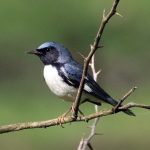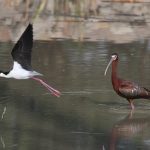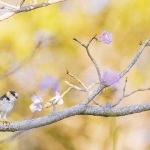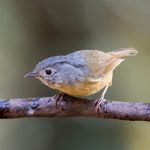Upland Sandpipers are one of the coolest and most awkward-looking of our continent’s birds. See, it’s not so scary! Photographed at Medicine Lake National Wildlife Refuge, MT.
Birders are a timid bunch. They are scared of all sorts of things. The thought of identifying certain groups of birds can incapacitate them. They are fearful of flycatchers. Galled at gulls. They wince at warblers. Wail at waterfowl. Flinch at finches. Grind teeth at grosbeaks. Gnaw themselves at gnatcatchers. Barf at blackbirds. Spew at sparrows. And…you guessed it…shed tears for shorebirds. Why? There’s nothing to be afraid of. I, for one, cannot stand it anymore, and as the best birder in the world, I feel it is my duty to improve the state of birding. And what better place to start than with shorebirds?
Some of you may remember that, as a child, I was completely blind for quite some time. What you don’t know is that as soon as I regained my vision, I began cutting my birding chops on shorebirds. The notion that they are hard to identify is completely foreign to me, considering that most of them don’t tend to hide behind anything and have pretty big ranges. Compared to something like a Connecticut Warbler, they are just begging to be looked at.
Birds like tanagers, warblers, buntings and orioles seem to get the most attention during spring migration, but millions of plovers and sandpipers are already winging their way north. I say to you, go and meet your local mud, rock, sand and grass-dwelling friends. They can be just as stunning.
American Avocets have won the hearts and minds of many a birder. Photographed at Radio Road, Redwood Shores, CA.
The most important thing to remember when identifying shorebirds is that it is actually easy. Once you accept this basic fact, you will be surprised at the ease in which you will find yourself identifying peeps and plovers, left and right. Here are a few helpful tips.
1: Ask yourself, where the hell are you? Are you in Alaska? Yes? Ok…what habitat? A rocky shore? Huh. And there is a small gray and white thing in front of you with a mediumish orangish bill? Is it a Purple Sandpiper? It sure looks like it in the book, cool!
NO!!!! NO IT IS NOT A PURPLE SANDPIPER!!!! By figuring out what habitat and what state you are in, that can greatly simplify the process…and yes, you were looking at a Rock Sandpiper.
Here’s an easy one. I see some oysters and a black bird. Black Oystercatcher….right? Well, it is in the most literal sense, but this is a Black Turnstone. Photographed at Drakes Bay Oyster Company, Point Reyes, CA.
2: Look at the bird. Closely. Do you see? It’s not ugly. In fact, it may be the most beautiful thing you have ever seen. Don’t let your intimidation of Tringids, or what have you, get in the way of actually observing field marks…quit writing these birds off as some awful cabal of unidentifiables. The bird won’t mind if you want to know what color its legs are.
3: Listen to the bird: its not rude. Most of them are essentially telling you what species they are when they talk, so just focusing on appearance may make the identification process more complicated than it has to be.
I’ve seen my fair share of inexperienced birders hopelessly flounder when attempting to identify a plainly-dressed Willet walking around. But when a Willet takes flight, it becomes one of the most distinctive shorebirds on the continent. Photographed at Lostwood National Wildlife Refuge, ND.
I think Solitary Sandpiper is a proper bird to gauge one’s shorebird kung fu. If you can identify this bird for what it is, you will earn the respect of your elders and bring much honor to your family. Photographed at Des Lacs National Wildlife Refuge, ND.
4: Field guides exist for a reason. Use them. It has always baffled me when birders misidentify birds when they have perfectly good bird books literally strapped to their bodies. I have never actually opened one myself (never needed to), but people tell me they are quite helpful in aiding bird identification. That’s why they exist, right?
One of the many reasons you should tackle shorebirds is to learn how to identify this bird, the Bristle-thighed Curlew. The second-to-last North American bird to have its nest discovered, they split their time between a tiny chunk of Alaska and a smattering of Pacific Islands. You can even whistle at them and they will come to you.* Can you imagine the horror and abysmal (ABYSSMAL?) sinking feeling that would set in if you found out you saw one of these and didn’t know it? Photographed at Midway Atoll.
* = If you spend the rest of your life futilely whistling at Whimbrels, don’t blame me.
Look at these sandpipers. Their bills are obviously different lengths and shapes…they must be different species, right? WRONG. Female sandpipers often have significantly longer bills than their male counterparts of the same species, which is something worth remembering when identifying trickier species such as Semipalmated Sandpipers. Photographed at White Lake, ND.
Phalaropes have the reputation (well-earned, of course) of being highly aquatic, often foraging while swimming on the water. While this is often the case, phalaropes just as frequently can be found foraging on shorelines just like regular sandpipers. You may also have noticed that birds in high breeding plumage, like the female Wilson’s Phalarope in front here, can be quite fancy-looking compared to other plumages of the same species…if you find yourself locked in fear while looking at a mixed flock of shorebirds, focus on the brightest birds first…their identities may be a bit easier to figure out, and may help in getting a grip in the drabber birds. Photographed at White Lake, ND.
5: Get a scope. Just do it. Yes they are expensive, but ultimately, you will not only find birding more enjoyable, you will become a better birder. Having a scope is crucial for getting a firm grip on shorebirds, for obvious reasons.
6: And this is the only advice that I have requires any effort: memorize what you are supposed to look for, this will make the identification process much quicker and will instill some confidence in you. Some basics are overall size, shape, bill length, bill shape, bill color, leg length, primary projection, breast pattern (or lack thereof). Easy.
Look at this striking beast. Believe it or not, this black, white, and yellow thing is a shorebird. See, not so vague looking eh? This Pacific Golden-Plover made itself a lawn ornament on Midway Atoll.
Marbled Godwits will literally attack you for a seemingly endless amount of time if you get anywhere near their nests. I do not recommend this tactic as a way to learn their field marks. Medicine Lake National Wildlife Refuge, MT.
7. Love them! Shorebirds come in all shapes, colors, and sizes, migrate vast distances, and can have some of the most bizarre courtship displays in the bird world. It’s also a scientific fact that they have the cutest chicks of any birds.
And there it is birders…it doesn’t get much realer than that. See you on an incoming high tide near you!





















That is one heck of a cool post.
If I start to whistle here in Germany, will a Bristle-thighed come to me,… eventually? And which one of the two Solitary Sandpiper “species” do you reckon you have photographed in ND?
Cheers!
Excellent post! There’s one piece of advice in there that I know I failed to ask myself way too often as a bumbling newb:
1: Ask yourself, where the hell are you?
That step alone reduces your field guide from 318 pages to about two…presuming you’re aware the bird in front of you is a plover and not a cuckoo.
Very helpful advice, and a really fun post to read. Thanks!
Come to Broome-14 species of shorebirds in most flocks and you will overlook the Broad-billed Sandpipers amongst the Curlew Sandpipers as they will tuck their bills in for you! 🙂
http://www.broomebirdobservatory.com/
This was great. This is great. This will be great. This will have been great. etc.
Super photography here that Specific Golden Plover is outrageous…it makes me feel ways about stuff.
Great advice too. I guess I shudder at shorebirds a bit still, though mostly just from a general lack of experience than taxonomical intimidation (honestly, shouldn’t SANDpipers be all over the Arizona desert???).
Is it possible to become Number 1 birder without fighting Godwits? That seems unlikely at any rate as a quick break-down of the name indicates, “God-Wills-It”–the final test for a birding hero.
Keep up the epic work there Seagull/Felonious person.
@Jochen – Thanks! I would reserve German curlew-whistling for extreme old age. Im not sure what you meant about the Solitary species…
@Kirby – Yup…despite our love of vagrants, bird are usually right where they are supposed to be.
@Wendy – Cheers!
@Clare – I would love nothing more than go birding in Australia…someday, someday…mmm, Broad-billed Sandpiper.
@Laurence – We all must face the godwit someday. Keep shorebirding!
I just calculated today that it will take me 2,500 years to find a Crested Honeybuzzard amongst our ordinary Honeybuzzards. So here you have it: old age, Crested HB’s and Bristle-thighed Curlews…
About the Solitaries: in 2006/07 during my time in Ann Arbor, there was considerable buzz about a study that had shown huuuuuge genetic differences between the two subspecies of Solitaries, a difference that was easily within the range of separate species. Everyone was expecting an instant split, but then all went silent.
My god…I didnt even hear about that…the AOU must be supressing information…we need FULL DISCLOSURE!!!
Thanks for the site–giving me courage to learn these these cute little devils. The excellent pics help tons!